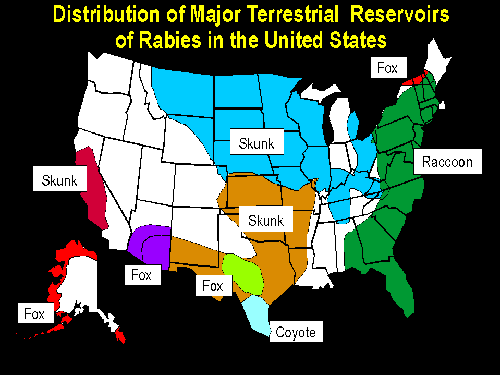

|
| Figure 2: Distribution of major terrestrial reservoirs of rabies in the United States, 1999 (reproduced with permission from the Journal of the AVMA, 19991) |
Skunks:
Skunks are the second most frequently reported rabid animal in this country.
Three virus variants are responsible for rabies in skunks. There are two
large geographically distinct reservoirs of skunk rabies due to three
different variants of the virus: one in California; the other in the central
United States from Montana to Texas. Rabid skunks reported in eastern states
outside the reservoir areas apparently were infected by raccoons rather than
by other skunks.
Foxes:
Two variants of the rabies virus are associated with persistent reservoirs
of rabies in foxes. One long-standing reservoir involves arctic and red
foxes in Alaska (and Canada) and to a lesser extent, areas of New York,
Vermont, New Hampshire, and Maine. A different variant of the virus has been
associated with gray foxes, resulting in reservoirs in Texas and Arizona.
Coyotes:
A rabies variant found in domestic dogs along the Texas-Mexico
border is currently present in coyotes in southern Texas. Northward spread
of this reservoir has been limited by an aggressive (and expensive)
airdrop vaccination program.
Bats:
Rabid bats of many different species have been found in all of the 48
contiguous states. To date, only one rabid bat has ever been identified in
Alaska -- in the southeastern part of the state. No rabid bats (or other
rabid animals) have ever been identified in Hawaii.
Rodents/small mammals:
Providers are often asked about the risks associated with small wild
mammals -- such as rats, mice, squirrels, chipmunks, rabbits and hares.
Rodent bites are common, so rodents are often tested for rabies in the
United States. Despite the large number of rodents examined, it is
exceedingly uncommon for one to be infected with rabies virus. It has been
postulated that these animals are so small that they are unlikely to survive
an attack of a larger rabid animal (such as a raccoon, skunk, or fox).
No rabid rodents have ever been identified in Washington. Furthermore,
although there have been several case reports of humans infected by rabid
rodents in other countries, no transmission of rabies from a rodent to a
human (or any other mammal) has ever been documented in the United
States2.
Other animals:
Other wild animals in the United States are occasionally found to be rabid.
Most are infected with virus strains associated with terrestrial animal
species, rather than bats. In 1999, 86 rabid non-reservoir wild animals were
reported from 25 of 50 states, including 31 groundhogs and 24 bobcats1. None were identified in Washington.
Rarely, other animals are found to be rabid, particularly in areas with bat
rabies. A rabid goat18and a rabid
kitten19each resulted in multiple
potential exposures for children in the eastern United States.